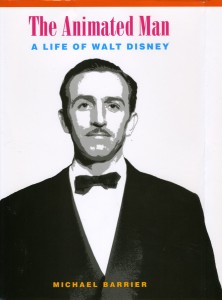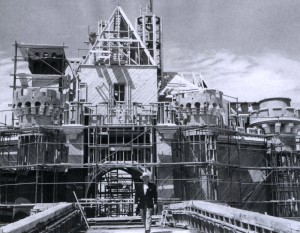Books &Commentary 18 Jun 2007 07:43 am
The Animated Man
 – Michael Barrier‘s The Animated Man: A Life of Walt Disney is unlike any other Disney biography I’ve read. (Since I think I’ve read about 90% of them, that’s quite a statement for me.)
– Michael Barrier‘s The Animated Man: A Life of Walt Disney is unlike any other Disney biography I’ve read. (Since I think I’ve read about 90% of them, that’s quite a statement for me.)
On my initial reading of the first half, I was ready to proclaim the book one of the finest animation books ever written. All the information on Disney’s developing studio in the 20’s, the backstabbing, deal making, and filmmaking was so well organized, detailed and well developed in the book that it was crystal clear where, why and how Disney was pushing his organization to a larger state. Where else have we read that the Disney brothers were HAPPY when Ub Iwerks left?
The story gets even more intense as Snow White grew to completion. We learn about the budget developments, the artistic growth within the studio and the push to meet the final screening. Where else have we read that the final bank loan from BankAmerica wasn’t a make or break it deal, that the studio would NOT go bankrupt if they didn’t get it. And they knew in advance that they were going to get it!
Walt Disney seems to get somewhat confused after the successful opening of Snow White and the large amounts of money that came back to the studio. Prior to this, I had always thought Pinocchio, Bambi et al were well into production as Snow White came to an end, so that there was a smooth transition from the first feature into the line-up of others. But, no. There was a lot of confusion within the studio as productions got switched and development turns from one to another.
Apparently Disney was a restless guy. A revealing comparison between Walt and his father is made, a man who seemed to go from one career to another so wildly in those early years that, prior to this book, I often wondered if everyone was like that at the turn of the 20th Century. I came to realize that these two guys had much in common and were unlike many others of their time.
In many ways it reminds me of something in the Ub Iwerks biography, The Hand Behind the Mouse, by John Kenworthy & Linda Iwerks. That book states that Iwerks felt that once he mastered something, he moved on. He bowled obsessively until he hit a perfect score, 300; then he never bowled again. In some ways it seems as if this were also true of Walt Disney. Once he did something, he moved onto something bigger and more challenging.
The restlessness shows in Disney’s split interest in the features that immediately followed Snow White. The attempts to make money had them thinking about live action from the  earliest days. I don’t think anyone has written before about this atmosphere from Disney’s point of view.
earliest days. I don’t think anyone has written before about this atmosphere from Disney’s point of view.
The book goes from the Strike to the War to Live Action. Slowly the interest in animation wanes, and the book puts its attention on the aspects of Disney’s world that HE was interested in. When his all-consuming passion shifts away from animation to live action, to the theme parks, to city construction and planning, the book follows this, almost exclusively.
(Images from the book enlarge when clicked.)
This is where it becomes less an animation book – possibly the best animation writing done on Disney, it’s so informative – to the Biography we expected. However, there’s as much detail about Disneyland or EPCOT from Disney’s point of view as there was about animation.
It’s so thoroughly researched that you feel confident that the picture you’re reading is undoubtedly accurate.
For the first half of this book, this is an animator’s version of Disney. The biography we always wanted. When Disney loses interest in animation, the book seems to shift as well, and it should. The true-life adventure films, for example, get more attention than Lady
and the Tramp, which is barely mentioned. In a biography of Disney this is probably appropriate, but as an animation die-hard this is my interest, and consequently the problems with the book, for the most part, are my fault. I got so much about animation at the beginning that I hoped for more later on.
I also wanted more about some of the personal aspects of Disney’s life. I expected, for example, to read more about the death of Disney’s mother; it seems so briefly tossed out in one paragraph I was struck, surprised, at how little attention was given to her accidental death. Disney must have felt guilt over her death when the new home built by the two sons had a faulty gas tank, and she died of asphyxiation, yet so little about it is explored (with a footnote advising us to go to a Bob Thomas book if we’re looking for more detail.)
This made me assume, once I hit this point, that the book was more interested in Disney the entrepreneur/businessman than in Disney the son/husband/father. The private side of Disney, I understand, was less about his personal side than his work. No vacation went without work, no lunch or private conference on the polo field went without discussion of Disney’s interest. The man didn’t have much of a personal life, so I understand the choice.
The focus stays firmly fixed on Walt Disney, the artist. It’s a unique read and one I’ll undoubtedly reread. There’s so much material and so much of it original research and commentary that, oddly, one almost wants more.
The book presents a man who helped to shape the first half of the 20th Century. It wasn’t just in his animation or his live action or his theme park development. It was in all of them, the man who was behind them all. The book offers this man with all of his pluses and minuses with hard-nosed information rather than stories, conjecture or rumor.
Barrier is a treasure among animation writers. His facts are indisputable, his information so all-enveloping, his toughts well-honed and at the top of the game. He’s written an excellent book; one that absolutely engrossed me and, at the same time, challenged me. I recommend it wholeheartedly (in case you couldn’t tell.) With half the number of pages of Neal Gabler‘s recent book, Michael Barrier gives us so much more.

on 19 Jun 2007 at 8:02 pm 1.James said …
Gabler did manage to pull off one amazing feat as a biographer: he made Walter Winchell dull.